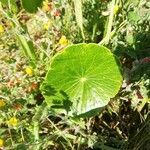A fleshy herb which keeps growing from year to year. The stem is creeping and underground and roots at the nodes. The leaf stalk is attached to the lower surface of the leaf, not the edge of the leaf. The leaf stalk is 2-35 cm long. The leaf blade is broad and 2-10 cm wide. It can have 12-20 shallow lobes or wavy edges. These have shallow scallops. There are many flowers in many umbels in a compound flower arrangement. The petals are whitish to yellow. The fruit are 1-2 mm long and 2-4 mm broad. They are heart shaped at the base.
Prostate, glabrous annual or perennial herb (hydrophyte), 0.1-0.3 m high; profusely rooting at nodes and matted. Leaves simple, blade lobed. Stipules on cauline leaves. Peduncles longer than subtending petioles. Flowers bisexual, in whorls along rays of umbels; pedicels 1-20 mm long. Petals white to cream-coloured. Fruit laterally compressed, lenticular.
Leaves peltate (very rarely with a deep narrow sinus extending to the petiole), on long petioles which may exceed 30 cm.; lamina up to 12 cm. in diameter, circular to broadly elliptic, with 12–20 veins radiating from the petiole; margin often shallowly lobed, the lobes with small secondary crenulations.
Fruit ellipsoid, flattened laterally, base cordate, stylopodium depressed to obsolete, styles c. 1 mm. long; commissure not strongly constricted, dorsal and lateral ribs well developed and quite acute in section; pericarp reddish-brown and slightly wrinkled when mature.
Stems slender; leaves 1-12 cm. in diameter, shallowly 12-19-lobed, the lobes crenate, glabrous, the petiole 2-38 cm. long, glabrous; peduncles glabrous, longer than the leaves; rays glabrous, 2-20 mm. long; fruit ellipsoid, 1-2 mm. long, 2-4 mm. broad, the ribs acute.
Inflorescence a proliferous umbel on a long slender peduncle which exceeds the subtending petiole. Umbel rays 5–7. When fully expanded, each ray forming a verticillate raceme, with the fruit in interrupted whorls.
Bracteoles lanceolate-acute, in whorls under each whorl of flowers. Pedicels slender, 1–20 mm. long; petals white to cream.
Glabrous creeping herbs with slender stems, rooting at the nodes.







